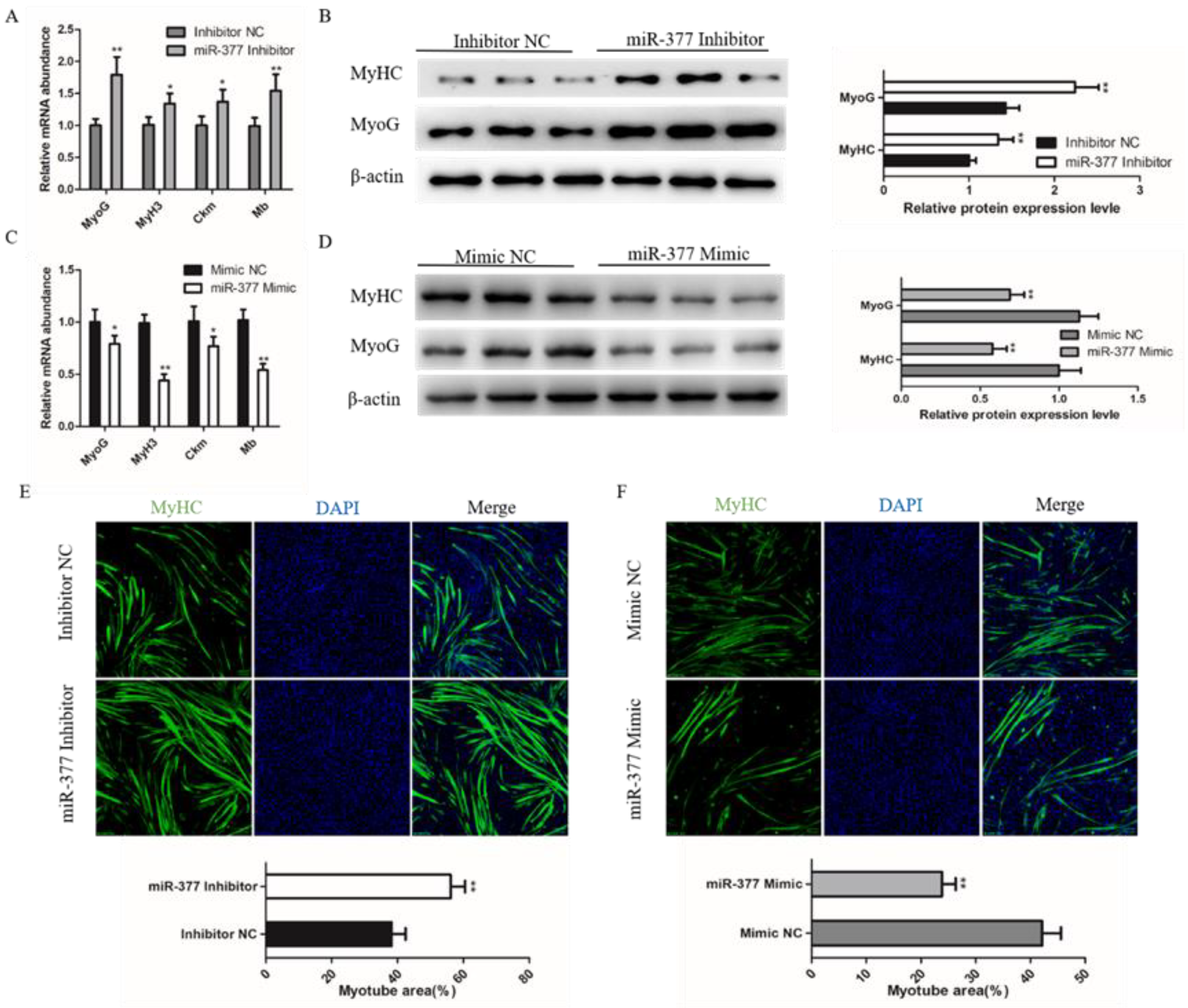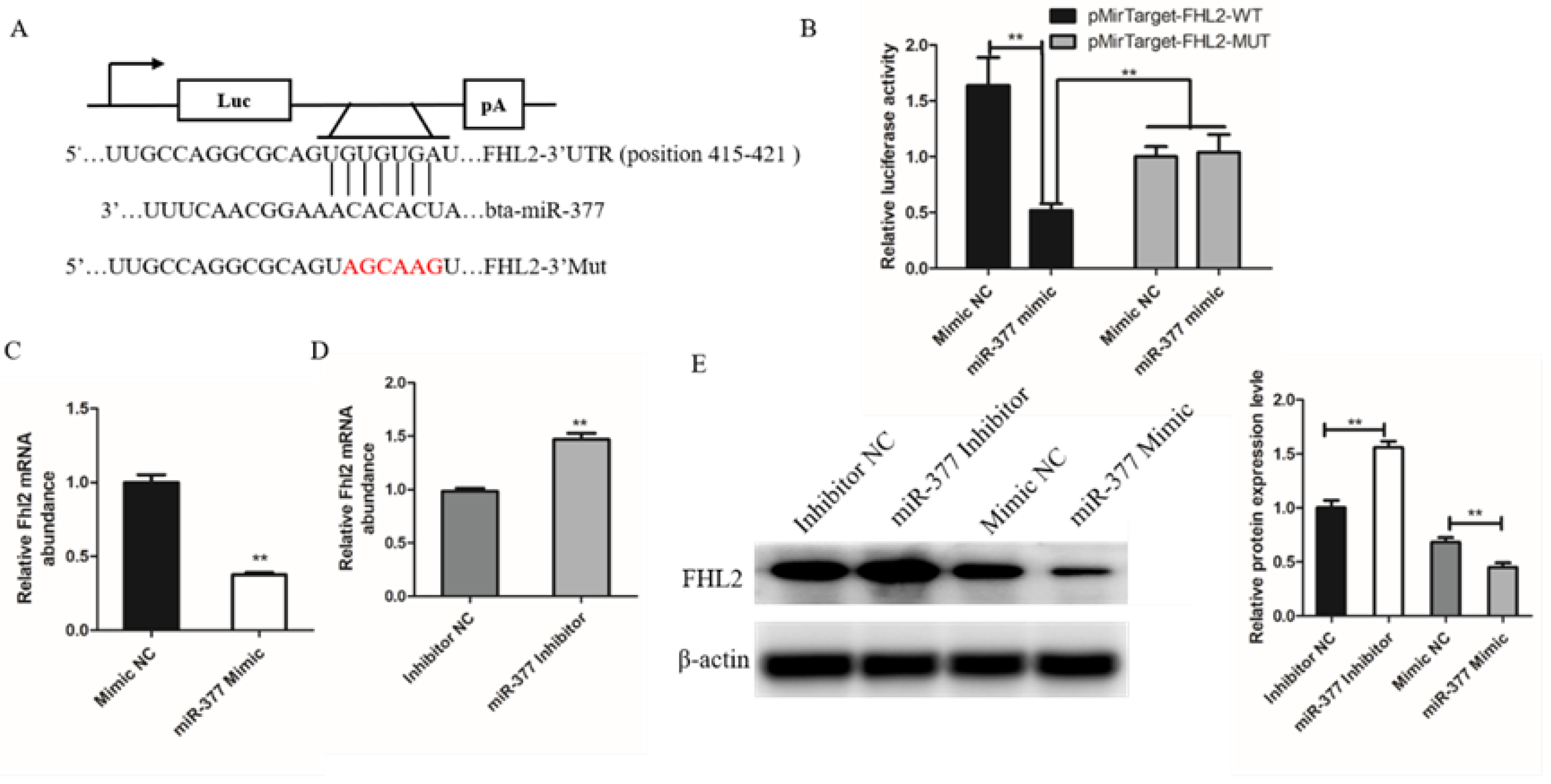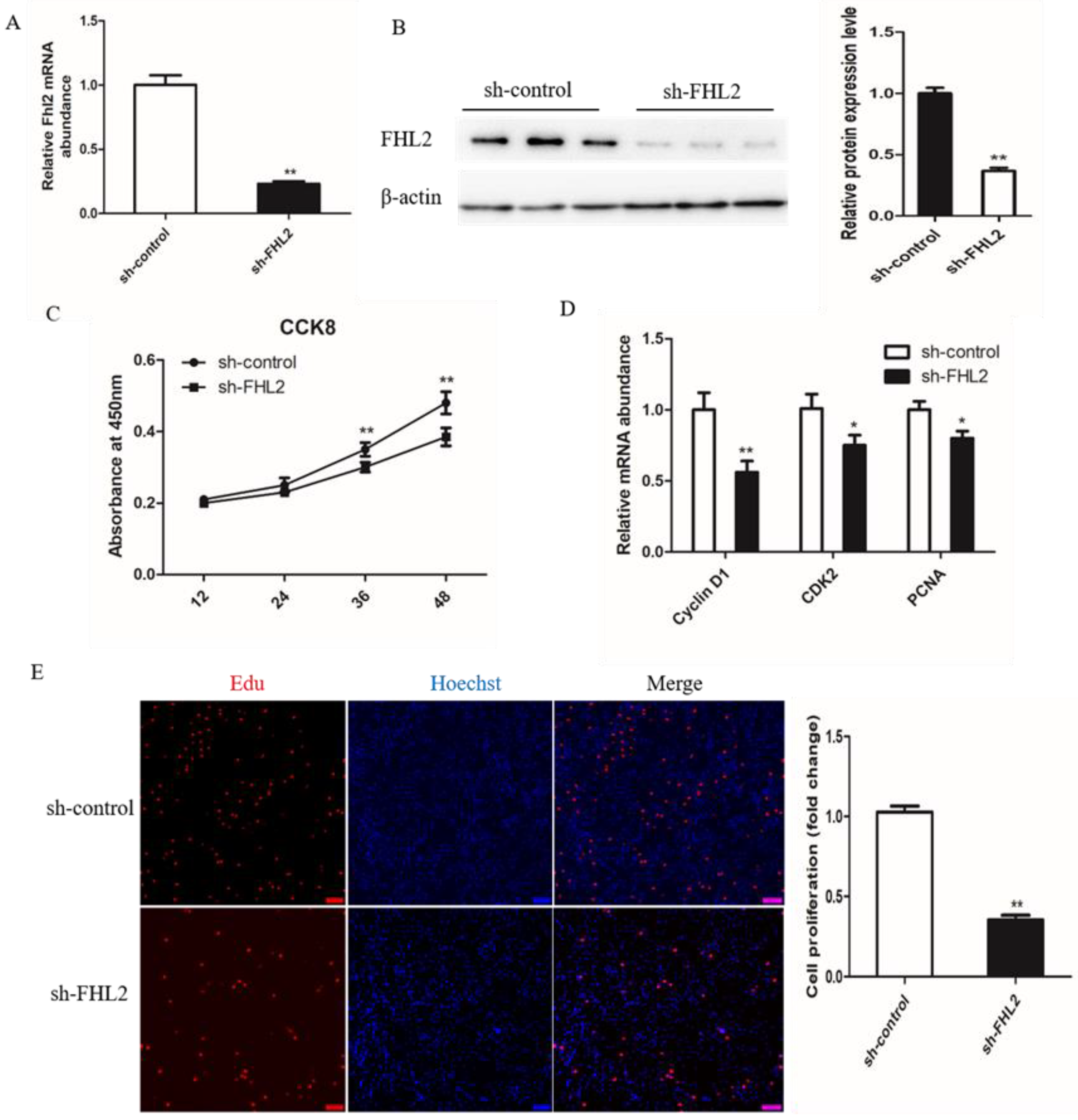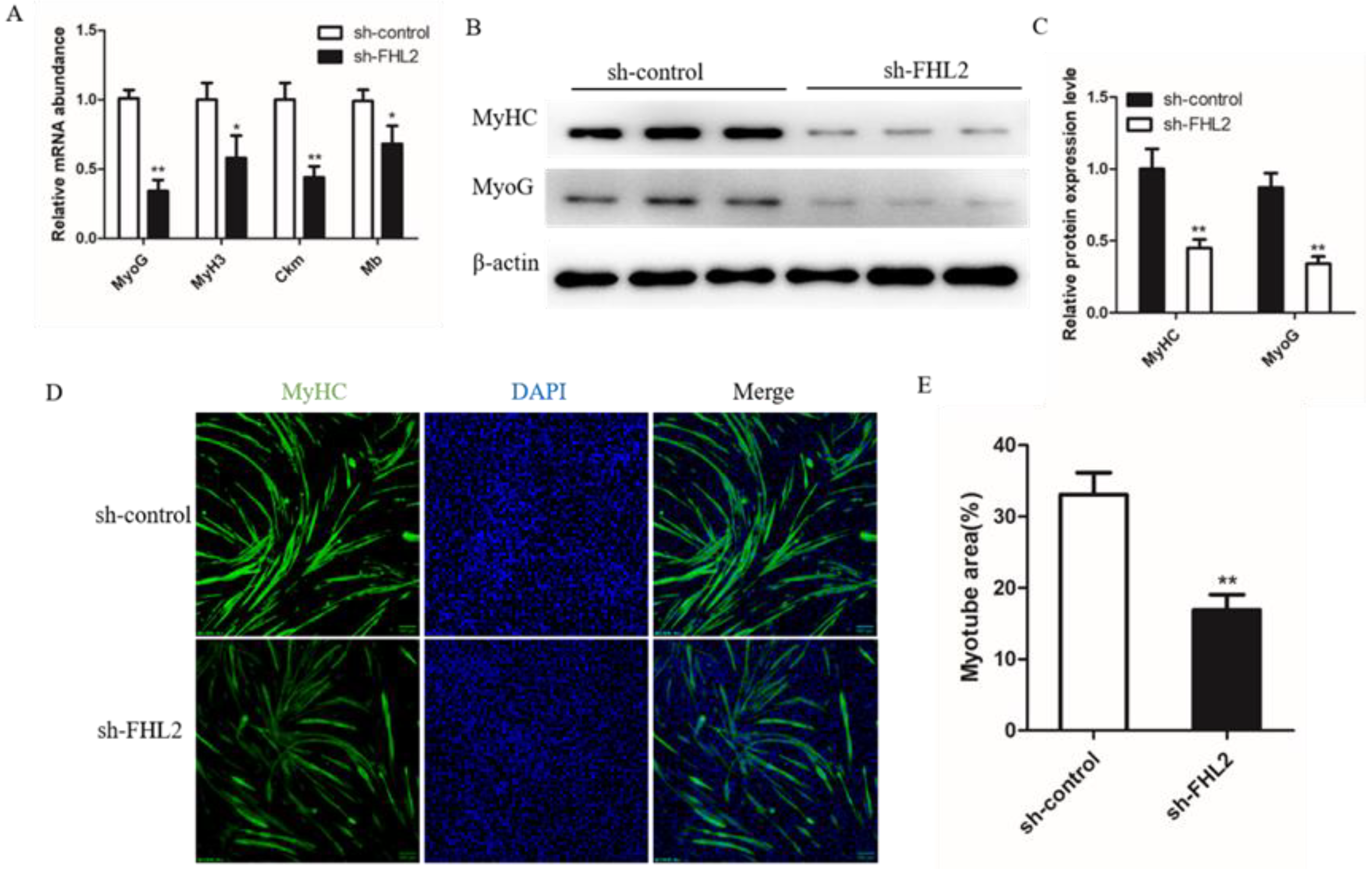miR-377 Inhibits Proliferation and Differentiation of Bovine Skeletal Muscle Satellite Cells by Targeting FHL2
Abstract
1. Introduction
2. Materials and Methods
2.1. Cell Culture
2.2. RNA Oligonucleotides, Vectors, and Transfection
2.3. RNA Isolation and Real-Time Quantitative PCR (qRT-PCR)
2.4. Western Blotting (WB) and Immunoprecipitation (IP) Analysis
2.5. Cell Counting Kit-8 (CCK-8) Assay
2.6. 5-Ethynyl-20-Deoxyuridine (EdU) Assay
2.7. Luciferase Reporter Assay
2.8. Statistical Analysis
3. Results
3.1. Expression Pattern of miR-377 in Bovine
3.2. miR-377 Inhibit the Proliferation of Bovine SMSCs
3.3. miR-377 Inhibits the Differentiation of Bovine SMSCs
3.4. miR-377 Directly Target FHL2 and Inhibit Its Expression
3.5. FHL2 Knockdown Inhibited the Proliferation of SMSCs
3.6. FHL2 Knockdown Inhibited Differentiation of SMSCs
3.7. miR-377 Disrupted the Dvl-2-Mediated Wnt Signaling Pathway in Bovine SMSCs
4. Discussion
5. Conclusions
Author Contributions
Funding
Institutional Review Board Statement
Informed Consent Statement
Data Availability Statement
Acknowledgments
Conflicts of Interest
References
- Mogensen, M.; Sahlin, K.; Fernstroem, M.; Glintborg, D.; Vind, B.F.; Beck-Nielsen, H.; Hojlund, K. Mitochondrial Respiration Is Decreased in Skeletal Muscle of Patients with Type 2 Diabetes. Diabetes 2007, 56, 1592–1599. [Google Scholar] [CrossRef]
- Braun, T.; Gautel, M. Transcriptional mechanisms regulating skeletal muscle differentiation, growth and homeostasis. Nat. Rev. Mol. Cell Biol. 2011, 12, 349–361. [Google Scholar] [CrossRef]
- Lepper, C.; Conway, S.J.; Fan, C.M. Adult satellite cells and embryonic muscle progenitors have distinct genetic requirements. Nature 2009, 460, 627–631. [Google Scholar] [CrossRef]
- Cossu, G.; Biressi, S. Satellite cells, myoblasts and other occasional myogenic progenitors: Possible origin, phenotypic features and role in muscle regeneration. Semin. Cell Dev. Biol. 2005, 16, 606–631. [Google Scholar] [CrossRef]
- Ke, X.; He, L.; Wang, R.; Shen, J.; Wang, Z.; Shen, Y.; Fan, L.; Shao, J.; Qi, H. miR-377-3p-Mediated EGR1 Downregulation Promotes B[a]P-Induced Lung Tumorigenesis by Wnt/Beta-Catenin Transduction. Front. Oncol. 2021, 11, 699004. [Google Scholar] [CrossRef]
- Zhang, X.Y.; Dong, X.M.; Wang, F.P. MiR-377-3p inhibits cell metastasis and epithelial-mesenchymal transition in cervical carcinoma through targeting SGK3. Eur. Rev. Med. Pharmacol. Sci. 2020, 24, 4687–4696. [Google Scholar]
- Huang, L.; Liu, Z.; Hu, J.; Luo, Z.; Zhang, C.; Wang, L.; Wang, Z. MiR-377-3p suppresses colorectal cancer through negative regulation on Wnt/β-catenin signaling by targeting XIAP and ZEB2. Pharmacol. Res. 2020, 156, 104774. [Google Scholar] [CrossRef]
- Yu, R.; Cai, L.; Chi, Y.; Ding, X.; Wu, X. miR-377 targets CUL4A and regulates metastatic capability in ovarian cancer. Int. J. Mol. Med. 2018, 41, 3147–3156. [Google Scholar] [CrossRef]
- Friedrich, F.W.; Reischmann, S.; Schwalm, A.; Unger, A.; Ramanujam, D.; Münch, J.; Müller, O.J.; Hengstenberg, C.; Galve, E.; Charron, P. FHL2 expression and variants in hypertrophic cardiomyopathy. Basic Res. Cardiol. 2014, 109, 451. [Google Scholar] [CrossRef]
- McLoughlin, P. The LIM-only Protein DRAL/FHL2 Interacts with and Is a Corepressor for the Promyelocytic Leukemia Zinc Finger Protein. J. Biol. Chem. 2002, 277, 37045–37053. [Google Scholar] [CrossRef]
- Arimura, T.; Hayashi, T.; Matsumoto, Y.; Shibata, H.; Hiroi, S.; Nakamura, T.; Inagaki, N.; Hinohara, K.; Takahashi, M.; Manatsu, S.I. Structural analysis of four and half LIM protein-2 in dilated cardiomyopathy. Biochem. Biophys. Res. Commun. 2007, 357, 162–167. [Google Scholar] [CrossRef]
- Hojayev, B.; Rothermel, B.A.; Gillette, T.G.; Hill, J.A. FHL2 Binds Calcineurin and Represses Pathological Cardiac Growth. Mol. Cell. Biol. 2012, 32, 4025–4034. [Google Scholar] [CrossRef]
- Lai, C.F.; Bai, S.; Uthgenannt, B.A.; Halstead, L.R.; Mcloughlin, P.; Schafer, B.W.; Chu, P.H.; Chen, J.; Otey, C.A.; Cao, X. Four and Half Lim Protein 2 (FHL2) Stimulates Osteoblast Differentiation. J. Bone Miner. Res. 2006, 21, 17–28. [Google Scholar] [CrossRef]
- Wei, Y.; Fabre, M.; Branchereau, S.; Gauthier, F.; Perilongo, G. Activation of β-catenin in epithelial and mesenchymal hepatoblastomas. Oncogene 2000, 19, 498–504. [Google Scholar] [CrossRef]
- Martin, B.; Schneider, R.; Janetzky, S.; Waibler, Z.; Pandur, P.; Kühl, M.; Behrens, J.; von der Mark, K.; Starzinski-Powitz, A.; Wixler, V. The LIM-Only Protein FHL2 Interacts with β-Catenin and Promotes Differentiation of Mouse Myoblasts. J. Cell Biol. 2002, 159, 113–122. [Google Scholar] [CrossRef]
- Algaber, A.; Madhi, R.; Hawez, A.; Rönnow, C.F.; Rahman, M. Targeting FHL2-E-cadherin axis by miR-340-5p attenuates colon cancer cell migration and invasion. Oncol. Lett. 2021, 22, 637. [Google Scholar] [CrossRef]
- Kong, L.; Zhang, C. LncRNA DLX6-AS1 aggravates the development of ovarian cancer via modulating FHL2 by sponging miR-195-5p. Cancer Cell Int. 2020, 20, 370. [Google Scholar] [CrossRef]
- Lyu, P.; Qi, Y.; Tu, Z.J.; Jiang, H. Single-cell RNA Sequencing Reveals Heterogeneity of Cultured Bovine Satellite Cells. Front. Genet. 2021, 12, 742077. [Google Scholar] [CrossRef]
- Wong, C.H.; Mak, W.Y.; Li, M.S.; Tsui, K.W. The LIM-only protein FHL2 regulates interleukin-6 expression through p38 MAPK mediated NF-κB pathway in muscle cells. Cytokine 2012, 59, 286–293. [Google Scholar] [CrossRef]
- Livak, K.J.; Schmittgen, T.D. Analysis of relative gene expression data using real-time quantitative PCR and the 2(-Delta Delta C(T)) Method. Methods 2001, 25, 402. [Google Scholar] [CrossRef]
- Wang, H.; Wei, Z.; Li, H.; Guan, Y.; Han, Z.; Wang, H.; Liu, B. MiR-377-3p inhibits atherosclerosis-associated vascular smooth muscle cell proliferation and migration via targeting neuropilin2. Biosci. Rep. 2020, 40, BSR20193425. [Google Scholar] [CrossRef]
- Zhang, P.; Wang, W.; Li, M. Circ_0010283/miR-377-3p/Cyclin D1 Axis Is Associated with Proliferation, Apoptosis, Migration, and Inflammation of Oxidized Low-density Lipoprotein-Stimulated Vascular Smooth Muscle Cells. J. Cardiovasc. Pharmacol. 2021, 78, 437–447. [Google Scholar] [CrossRef]
- Bachman, J.F.; Klose, A.; Liu, W.; Paris, N.D.; Blanc, R.S.; Schmalz, M.; Knapp, E.; Chakkalakal, J.V. Prepubertal skeletal muscle growth requires Pax7-expressing satellite cell-derived myonuclear contribution. Development 2018, 145, dev167197. [Google Scholar] [CrossRef]
- Dumont, N.A.; Bentzinger, C.F.; Sincennes, M.C.; Rudnicki, M.A. Satellite Cells and Skeletal Muscle Regeneration. Compr. Physiol. 2015, 5, 1027–1059. [Google Scholar]
- Liu, Z.; Han, S.; Wang, Y.; Cui, C.; Zhu, Q.; Jiang, X.; Yang, C.; Du, H.; Yu, C.; Li, Q.; et al. The LIM-Only Protein FHL2 is involved in Autophagy to Regulate the Development of Skeletal Muscle Cell. Int. J. Biol. Sci. 2019, 15, 838–846. [Google Scholar] [CrossRef]
- Shi, X.; Bowlin, K.M.; Garry, D.J. Fhl2 interacts with Foxk1 and corepresses Foxo4 activity in myogenic progenitors. Stem Cells 2010, 28, 462–469. [Google Scholar] [CrossRef]
- Han, X.H.; Jin, Y.R.; Seto, M.; Yoon, J.K. A WNT/β-Catenin Signaling Activator, R-spondin, Plays Positive Regulatory Roles during Skeletal Myogenesis. J. Biol. Chem. 2012, 286, 10649. [Google Scholar] [CrossRef]
- Brun, J.; Dieudonné, F.X.; Marty, C.; Müller, J.; Schüle, R.; Patiño-García, A.; Lecanda, F.; Fromigué, O.; Marie, P.J. FHL2 Silencing Reduces Wnt Signaling and Osteosarcoma Tumorigenesis In Vitro and In Vivo. PLoS ONE 2013, 8, e55034. [Google Scholar] [CrossRef][Green Version]
- Cy, L.; Wang, L.; Zj, L.; Gao, P.; Af, H.; Yuan, Z. Plumbagin Shows Anti-proliferative Effect in Human Osteosarcoma Cells by Down Regulating FHL2 and Interfering with WNT/Β-Catenin Signalling. West Indian Med. J. 2016, 12, 1095–1100. [Google Scholar]
- Duan, Y.; Qiu, Y.; Huang, X.; Dai, C.; He, W. Deletion of FHL2 in fibroblasts attenuates fibroblasts activation and kidney fibrosis via restraining TGF-β1-induced Wnt/β-catenin signaling. J. Mol. Med. 2020, 98, 291–307. [Google Scholar] [CrossRef]
- Li, S.-Y.; Huang, P.-H.; Tarng, D.-C.; Lin, T.-P.; Yang, W.-C. Four-and-a-Half LIM Domains Protein 2 Is a Coactivator of Wnt Signaling in Diabetic Kidney Disease. J. Am. Soc. Nephrol. JASN 2015, 26, 3072–3084. [Google Scholar] [CrossRef]
- Pulvirenti, T.; Van Der Heijden, M.; Droms, L.A.; Huse, J.T.; Tabar, V.; Hall, A. Dishevelled 2 Signaling Promotes Self-Renewal and Tumorigenicity in Human Gliomas. Cancer Res. 2011, 71, 7280–7290. [Google Scholar] [CrossRef]
- Mcloon, L.K.; Rowe, J.; Wirtschafter, J.; Mccormick, K.M. Continuous myofiber remodeling in uninjured extraocular myofibers: Myonuclear turnover and evidence for apoptosis. Muscle Nerve 2004, 29, 707–715. [Google Scholar] [CrossRef]
- Ozbek, E.; Adas, G.; Otunctemur, A.; Duruksu, G.; Karaoz, E. Role of Mesenchymal Stem Cells Transfected with Vascular Endothelial Growth Factor in Maintaining Renal Structure and Function in Rats with Unilateral Ureteral Obstruction. Exp. Clin. Transplant. 2014, 13, 262. [Google Scholar]







| Name | Forward Primer (5′–3′) |
|---|---|
| FHL2-shRNA | GCAAGGACUUGUCUUAUAATT |
| UUAUAAGACAAGUCCUUGCTT | |
| MiR-377 mimic | AUCACACAAAGGCAACUUUUGU |
| Mimic NC | UUGUACUACACAAAAGUACUG |
| MiR-377 inhibitor | ACAAAAGUUGCCUUUGUGUGAU |
| Inhibitor NC | CAGUACUUUUGUGUAGUACAA |
| Genes | Forward Primer (5′–3′) | Size (bp) | Annealing Temperature (°C) | Accession Number |
|---|---|---|---|---|
| FHL2 | F: CTCTGCGCTTCTCAGCGATA | 128 | 61 | NM_001046046.2 |
| R: GGCAGGAAGTTACACCGGAA | ||||
| Ckm | F: CCTGACGGGTGAGTTCAAGG | 187 | 60 | NM_174773.4 |
| R: TGATCCTCCTCGTTCACCCA | ||||
| MyoG | F: TGGGCGTGTAAGGTGTGTAA | 78 | 60 | NM_001111325.1 |
| R: TATGGGAGCTGCATTCACTG | ||||
| MyH7 | F: CTTCAACCACCACATGTTCG | 178 | 58 | NM_174727.1 |
| R: GCTTCTGGAAGTTGCTGGAC | ||||
| Wnt5a | F: CAACTGGCAGGACTTTCTCAA | 127 | 61 | NM_174727.1 |
| R: CATCTCCGATGCCGGAACT | ||||
| Wnt10b | F: CTCTGCCACAGCCAAACTCT | 106 | 60 | XM_010805029.3 |
| R: ATCGAACTTGCCTGGCTTGA | ||||
| c-Myc | F: GTAATTCCAGCGAGAGGCAGA | 213 | 60 | NM_001046074.2 |
| R: CTAGGCTAGCTCGGCTCTTC | ||||
| Lef1 | F: CCCTGTGTTGTTCGGCCTC | 271 | 59 | NM_001192856.1 |
| R: ATTGGAAGGATGCGTCAGGG | ||||
| CyclinD1 | F: ATGAAGGAGACCATCCCCCT | 117 | 61 | NM_001046273.2 |
| R: CGCCAGGTTCCACTTGAGTT | ||||
| CDK2 | F: AGGGAACGTACGGAGTTGTG | 78 | 58 | NM_001014934.1 |
| R: GACATCCAGCAGCTTGACAAT | ||||
| PCNA | F: TCCAGAACAAGAGTATAGC | 162 | 60 | NM_001034494.1 |
| R: TACAACAGCATCTCCAAT | ||||
| miR-377 | F: ATCACACAAAGGCAACTTTTGT | / | 60 | / |
| R: CAGGTCCAGTTTTTTTTTTTTTT | ||||
| MB | F: ACTGACCTGCACCTTTACCC | 210 | 62 | NM_173881.2 |
| R: CTCAGGGCAAGCAAGACACT | ||||
| β-actin | F: CATCCTGACCCTCAAGTA | 146 | 56–62 | NM_173979.3 |
| R: CTCGTTGTAGAAGGTGTG | ||||
| U6 | F: GCTTCGGCAGCACATATACTAAAAT | / | 60 | / |
| R: CGCTTCACGAATTTGCGTGTCAT |
Publisher’s Note: MDPI stays neutral with regard to jurisdictional claims in published maps and institutional affiliations. |
© 2022 by the authors. Licensee MDPI, Basel, Switzerland. This article is an open access article distributed under the terms and conditions of the Creative Commons Attribution (CC BY) license (https://creativecommons.org/licenses/by/4.0/).
Share and Cite
Zhu, Y.; Li, P.; Dan, X.; Kang, X.; Ma, Y.; Shi, Y. miR-377 Inhibits Proliferation and Differentiation of Bovine Skeletal Muscle Satellite Cells by Targeting FHL2. Genes 2022, 13, 947. https://doi.org/10.3390/genes13060947
Zhu Y, Li P, Dan X, Kang X, Ma Y, Shi Y. miR-377 Inhibits Proliferation and Differentiation of Bovine Skeletal Muscle Satellite Cells by Targeting FHL2. Genes. 2022; 13(6):947. https://doi.org/10.3390/genes13060947
Chicago/Turabian StyleZhu, Yun, Peng Li, Xingang Dan, Xiaolong Kang, Yun Ma, and Yuangang Shi. 2022. "miR-377 Inhibits Proliferation and Differentiation of Bovine Skeletal Muscle Satellite Cells by Targeting FHL2" Genes 13, no. 6: 947. https://doi.org/10.3390/genes13060947
APA StyleZhu, Y., Li, P., Dan, X., Kang, X., Ma, Y., & Shi, Y. (2022). miR-377 Inhibits Proliferation and Differentiation of Bovine Skeletal Muscle Satellite Cells by Targeting FHL2. Genes, 13(6), 947. https://doi.org/10.3390/genes13060947





